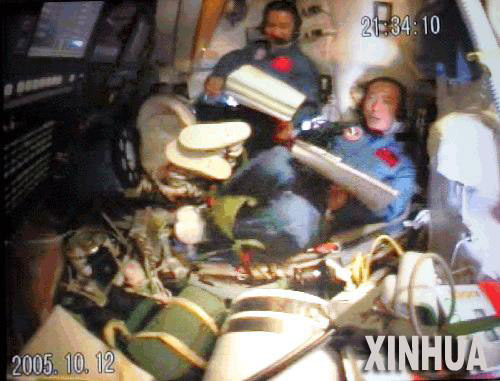Shenzhou 6 Astronauts Prepare for Landing

China's Shenzhou6 spacecraft and its two-astronaut crew prepared Sunday for their return toEarth after a five-day spaceflight, though Chinese space officials said theexact landing site will be decided hours before the planned touchdown.
Shenzhou6 astronauts Fei Junlong and Nie Haisheng will land in the early hours ofOct. 17 Beijing Time in either the Siziwang Banner region of Inner Mongolia innorth China, the mission's primary landing are, or at a backup site in the northwesternJiuquan region, state media reported, adding that weather forecasts predictfavorably landing conditions through Oct. 18.
"Decisionwill be made six hours before the spacecraft's return whether the re-entrycapsule will land at the primary landing site in Inner Mongolia or thisnorthwestern standby site," Zhu Yabin, chief of the land search and rescueteam, told China's official Xinhua News Agency.
Sixhelicopters, 14 special vehicles and more than 200 recovery workers have beenmobilized for Shenzhou 6's return at its primary landing site, according to SuiQisheng, chief commander in charge of landing, Xinhua reported.
"We have drawn out detailed plans to ensurethat rescue workers and equipment will arrive at where the capsule lands,"Sui told Xinhua.
Fei and Nie have orbited the Earth since launchingspaceward atop a Long March 2F rocket on Oct. 12 Beijing Time (Oct. 11 GMT).Their mission marks China's second manned spaceflight since the launch ofastronaut Yang Liwei aboard Shenzhou5 in 2003, as well as the country's first two-astronaut mission. China isthe third country to independently launch astronauts into Earth orbit afterRussia and the U.S. Its Shenzhou- or "Divine Vessel" - series spacecraft borrow a basic design from Russia's Soyuzspacecraft, but are heavily modified and modernized.
TheShenzhou 6 crew have flown nearly 1.8 million miles (2.8 million kilometers)and orbited the Earth more than 71 times during their spaceflight, China'sstate media reported.
Get the Space.com Newsletter
Breaking space news, the latest updates on rocket launches, skywatching events and more!
Fei and Niehave performed a series of physical experiments to test the integrity of theirspacecraft, as well as cytology, earth observation and human physiology tests, Xinhuasaid.
The twoastronauts - also known as "taikonauts" - said Sunday that they appreciated thesupport of their country, state media reported.
"We're grateful for the deep love andconcern by all Chinese people, the Hong Kong, Macao and Taiwancompatriots," Nie said in a space-to-ground transmission, according to Xinhua.
Fei reportedly added that he and Nie were "feelinggood" and "happy" in Earth orbit and planned to "do our utmost to fulfill themission," the news agency added.
The Shenzhou 6 spaceflight is designed to furtherChina's human spaceflight experience as it works toward developing a mannedspace station and serve as a symbol of national pride while demonstratingthe country's technological prowess.
State media reports also cited China's plans toselect femaleastronauts for future missions.
China's Air Force Aeronautics Universityaccepted its eighth group of female pilot trainees in July, and may prove thesource of the country's first female fighter pilots and first female astronaut,Xinhua said Saturday, adding that some students are hopeful they'll makethe cut.
"Mydream is to become China's first female fighter pilot and first femaletaikonaut," Tao Jiali, a student from southwest China's Sichuan Provinceto the university, told Xinhua Saturday.
- Shenzhou Rising: China's Second Manned Spaceflight
- Special Report: Emerging China, Engaging China
- ZOOM View: Close in on Shenzhou 6 on its Launch Pad
Join our Space Forums to keep talking space on the latest missions, night sky and more! And if you have a news tip, correction or comment, let us know at: community@space.com.

Tariq is the Editor-in-Chief of Space.com and joined the team in 2001, first as an intern and staff writer, and later as an editor. He covers human spaceflight, exploration and space science, as well as skywatching and entertainment. He became Space.com's Managing Editor in 2009 and Editor-in-Chief in 2019. Before joining Space.com, Tariq was a staff reporter for The Los Angeles Times covering education and city beats in La Habra, Fullerton and Huntington Beach. In October 2022, Tariq received the Harry Kolcum Award for excellence in space reporting from the National Space Club Florida Committee. He is also an Eagle Scout (yes, he has the Space Exploration merit badge) and went to Space Camp four times as a kid and a fifth time as an adult. He has journalism degrees from the University of Southern California and New York University. You can find Tariq at Space.com and as the co-host to the This Week In Space podcast with space historian Rod Pyle on the TWiT network. To see his latest project, you can follow Tariq on Twitter @tariqjmalik.









